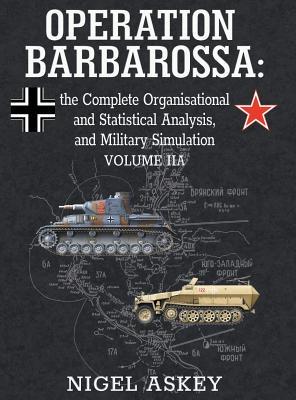Operation Barbarossa: the Complete Organisational and Statistical Analysis, and Military Simulation includes full analyses of the Axis and Soviet armed-forces organisation, weapons, equipment, personnel, transport, logistics, war-production, mobilisation and replacements during 1941. Uniquely, the work employs a sophisticated military simulation methodology extending from the tactical to the strategic level, and applies this methodology to each of the belligerents.
Volume IIA is concerned with the Wehrmacht. All the significant German weapon systems and combat squads used in the campaign are analysed using the quantitative methodology detailed in Volume I, along with the contextual history. An assessment of each weapon system's inherent 'combat power' is provided, as well as attributes such as the relative anti-tank, anti-personnel and anti-aircraft values. Volume IIA then focuses on the detailed Kriegstarkenachweisungen (KStN, or TOE) for German land units (including those in the West), as well as the unit's actual organisation and equipment. All significant units in the German Army, Waffen SS, Luftwaffe and security forces are included; ranging from the largest panzer divisions, down to small anti-aircraft companies, military-police units, Landesschutzen battalions, and rail-road and construction companies. In all cases the data is presented in detailed tables, using the weapon systems and combat squads previously analysed.
Operation Barbarossa: the Complete Organisational and Statistical Analysis, and Military Simulation collates an immense amount of information from many sources, and presents it with contextual history and analyses. The professional researcher or amateur scholar is provided with a comprehensive data source, containing the details of all the armed forces involved on the East-Front during 1941, as well as the relevant economic and logistical support. The complete work represents the most accurate, advanced and comprehensive quantitative analysis yet, of the East-Front campaign. Currently no other single work provides a comparable reference on the actual Soviet and Axis land, air and naval forces involved in what was the most decisive campaign of WWII.

Operation Barbarossa: the Complete Organisational and Statistical Analysis, and Military Simulation, Volume IIA
Operation Barbarossa: the Complete Organisational and Statistical Analysis, and Military Simulation includes full analyses of the Axis and Soviet armed-forces organisation, weapons, equipment, personnel, transport, logistics, war-production, mobilisation and replacements during 1941. Uniquely, the work employs a sophisticated military simulation methodology extending from the tactical to the strategic level, and applies this methodology to each of the belligerents.
Volume IIA is concerned with the Wehrmacht. All the significant German weapon systems and combat squads used in the campaign are analysed using the quantitative methodology detailed in Volume I, along with the contextual history. An assessment of each weapon system's inherent 'combat power' is provided, as well as attributes such as the relative anti-tank, anti-personnel and anti-aircraft values. Volume IIA then focuses on the detailed Kriegstarkenachweisungen (KStN, or TOE) for German land units (including those in the West), as well as the unit's actual organisation and equipment. All significant units in the German Army, Waffen SS, Luftwaffe and security forces are included; ranging from the largest panzer divisions, down to small anti-aircraft companies, military-police units, Landesschutzen battalions, and rail-road and construction companies. In all cases the data is presented in detailed tables, using the weapon systems and combat squads previously analysed.
Operation Barbarossa: the Complete Organisational and Statistical Analysis, and Military Simulation collates an immense amount of information from many sources, and presents it with contextual history and analyses. The professional researcher or amateur scholar is provided with a comprehensive data source, containing the details of all the armed forces involved on the East-Front during 1941, as well as the relevant economic and logistical support. The complete work represents the most accurate, advanced and comprehensive quantitative analysis yet, of the East-Front campaign. Currently no other single work provides a comparable reference on the actual Soviet and Axis land, air and naval forces involved in what was the most decisive campaign of WWII.